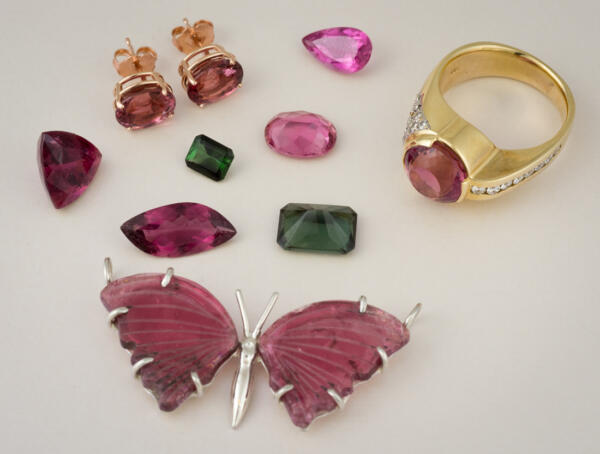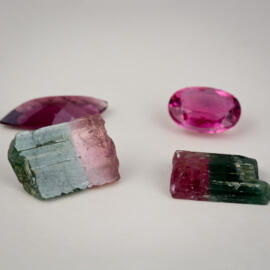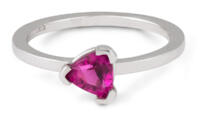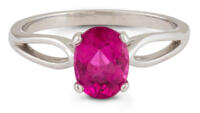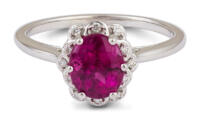Gem in the Spotlight: Tourmaline
A gem of many colors
Tourmaline is one of the most beautiful gems that you’ve probably never heard of. Less popular than the likes of ruby or sapphire, tourmaline flies under the radar in the gem world and remains the best kept secret of gem collectors and connoisseurs who appreciate its unique properties and stunning array of colors.
In fact, tourmaline is found in almost any color you can imagine, and people have most likely used and appreciated it for hundreds of years. But, before the advent of modern gemology, most tourmaline was believed to be ruby, sapphire, or emerald.
Gemology of Tourmaline
Gemologically speaking, tourmaline is its own mineral and not a species or member of a different family (unlike emerald and aquamarine, for example, which are members of the beryl family). It has a refractive index of 1.624 to 1.644 and a Mohs hardness of 7 to 7.5 which makes it softer than topaz or sapphire and harder than tanzanite or opal.
Tourmaline is found in a huge variety of colors (sometimes even within the same gem), and some of these colors have their own names:
- Rubellite: is red, pinkish red, orangy red, or pink tourmaline.
- Indicolite: is dark blue, dark violetish blue, or dark greenish blue tourmaline.
- Paraíba: is a copper colored blue, intense violetish blue, or greenish blue tourmaline from Paraíba, Brazil.
- Chrome tourmaline: is a vibrant and intense green. Most of chrome tourmaline’s color actually comes from vanadium.
- Watermelon: This variant of tourmaline has a pink center and green edges that resembles a watermelon. Crystals of this type are often cut in slices to display this unique property.
One of tourmaline’s most distinctive traits is its ability to be multicolored as mentioned above with watermelon tourmaline. The gemological term for this is parti-colored tourmaline. This includes bi-color, tri-color, and more. The most common combination of colors is green and pink, but many other combinations of colors exist. Parti-colored tourmaline occurs when the gem is getting formed and the environment changes. Depending on which trace elements are present, as well as their concentration, different colors will be present. Copper, manganese, chromium, and vanadium are the key coloring agents in tourmaline.
Another unique facet of tourmaline is its ability to become electrically charged in certain circumstances. In particular it demonstrates:
- Pyroelectric effects: When heated, tourmaline becomes electrically charged.
- Piezoelectric effects: Tourmaline becomes electrically charged when under mechanical stress (squeezed or impacted). This effect allowed the stone to be used in early sonar systems in the First World War as well as in extremely sensitive pressure gauges in submarines.
History and Lore of Tourmaline
The name tourmaline comes from the Singhalese word turamali, which means “mixed gems” owing to the fact that the gem can look like many others.
Tourmaline was first discovered in 1554 in Brazil when Francisco Spinoza’s expedition confused its vibrant green with that of emerald. Thus began a long trend of confusing tourmaline with other gems. Another notable example of this is the “Caesars Ruby,” the 255ct stone in the Russian crown jewels that has been traded between France, Russia, and Sweden for centuries. It was long been believed to be one of the largest rubies ever found until it was identified as rubellite in 1922.
Folklore suggests that tourmaline could help improve self-awareness, self-confidence, psychic energies, communication, and the ability to relax. In the 18th century, a Dutch scientist claimed that a tourmaline crystal wrapped in silk and placed on the cheek of a feverish child would help them fall asleep. The gem was also highly valued by alchemists who, perhaps because of its pyroelectric effect, believed it to be related to the Philosopher’s Stone. The Philosophers Stone is a mythical material thought to have the power to grant enlightenment, give power over spiritual affairs, reconcile opposites, and change base metals to gold.
Tourmaline has a special place in our hearts as California natives because it is one of the few gems that are found right here in the Golden State. Tourmaline was first discovered in California in 1892. It quickly became known as an American gem through the efforts of gemologist George F. Kunz. He documented reports about the tourmaline deposits of Maine and California and praised the quality of the stones they produced.
Along with opal, tourmaline is October’s birthstone.
Care and Cleaning of Tourmaline
Tourmaline makes a great gem in a ring for occasional wear or a pendant/earrings for daily wear. Because it isn’t exceptionally hard (Mohs hardness of 7-7.5), it should be stored away from other gemstones that could potentially damage it.
Tourmaline should not be put into an ultrasonic cleaner or steam cleaned, and should only be cleaned with warm, soapy water. With proper care, a piece of tourmaline jewelry can last generations and even become a treasured family heirloom.
Why Tourmaline
So, now that you know a bit more about this unique and beautiful gem, why would you add it to your collection? Maybe you love seeing a single gem with multiple colors. Maybe you like the idea of buying a gem mined locally, right here in California. Maybe you just appreciate the vibrant colors and rich history of this very special gem.
Whatever your reason, you can’t go wrong with a beautiful piece of tourmaline jewelry, and the gemologists here at Arden Jewelers are ready to help you find the perfect piece for you. Contact us today to get started.
